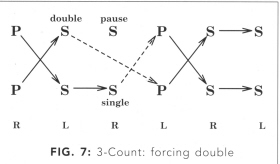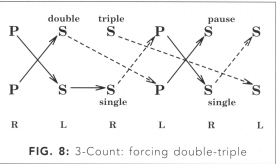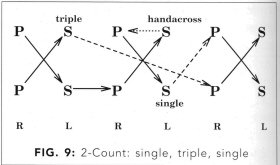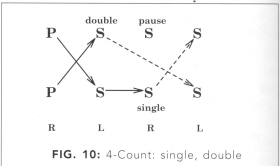Since
forced extra passes are a new thing, you will probably find them
somewhat tricky at first. In particular, being ready for
these passes means keeping an eye on your partner at times when you
didn't think you needed to. But it's not hard to get used to. You
simply have to know, in advance, what to look for and what the
response is.
To
spot the above 2-ct forced pass, watch your partner's R hand to see if
it is passing (a double) after the L double. If it is, you immediately
pass a L back to that R hand. This is almost always the case here -
the forced pass is thrown to the hand that forced the pass.
Below
are more challenging forced responses to try. In all of
these, the responding return pass occurs one count after the forcing
pass is thrown.
Once you and your partner can respond appropriately to a given forcing throw, try the following. While you're doing the basic pattern, each of you can occasionally do the special sequence, with and without the forcing throw. This way you won't know in advance which of you will throw something special next nor will you know whether you'll be forced to make an extra pass until the actual forcing throw comes. This will teach you to stay alert for the various alternatives that might come your way. It's fun too.
Extra
Passes in a 3-Count In a 3-count, immediately after a normal single pass from the R, throw a diagonal double from the L instead of a self. Then pause for one count before returning to the normal rhythm. That is, you throw: single, double, pause; single, self, self. Since you pass one more club than normal, your partner has to make an extra pass back somewhere (or else start juggling four clubs). Note that the two normally passed clubs keep going back and forth, but an interloper joins them occasionally. Can you figure out what pass your partner has to make to even things up? See Fig. 7. Again the extra pass goes back to the hand that forced it, namely the hand that threw the double.
For another site swap in a 3-count, do the same as the above, but after the diagonal L double, throw a straight R triple. The first person's sequence is thus: single, double, triple; single, pause, self. This time the respondent has to return two clubs with extra passes. Because the double and triple come down to the same hand, the respondent makes both extra return passes with one hand (see Fig. 8). Both jugglers must remember to pass on the regular 3-count passing beat (right after the triple).
Extra
Passes in a 2-Count In a 2-count, you can throw an earlylate L-to-R triple immediately after any R single. Normally, you would then pause for one count, omitting the following R single. But if, instead of pausing, you actually go ahead and pass that following R single (an extra pass), then your partner will have to make an extra pass back to you to avoid having four clubs (in fact, in order to avoid having two clubs come down to the same hand at the same time). It's not hard to figure out where your partner can add a pass, since one hand is already busy passing all the time. After you throw the triple and the following single, however, your R hand is empty, so you need to hand a club across from your left to your right to get it there in time for the next R pass. That makes your sequence: single, triple; single, hand-across; single, self. See Fig. 9. (Again, instead of the hand-across, you could throw a double.)
Extra
Passes in a 4-Count In a 4-count, if you follow a normal single with a L-to-L double, your partner will be forced to respond to that extra pass (see Fig. 10). This is relatively easy-just watch for a L double coming at the "wrong" time in the 4-count and if you see one, pass a R single back.
Creating
New Variations Once
you're used to responding with forced passes, you may find that you
even correct that way for accidental extra passes from your partner,
for instance if you're doing a 4-count and your partner accidentally
goes into a 2-count.
The
forced responses described here are not the only possible responses.
For instance, in the 2-count pattern where you throw single, triple,
single, your partner can use the general rule we stated at the
beginning of this article to change the extra return single into a
self L-to-L double!
This sort of transformation of an individual throw can always be used to modify a pattern, even after it has already been modified. In this way, you can build up more complex combinations with double and triples or whatever. The trick to doing this is knowing where the hand that you're throwing to is supposed to throw to next. It may be hard to figure that out in an instant while you're juggling, so just stop and map the pattern out if you need to. If you can create a causal diagram for the base pattern, then the possible special throws practically jump out at you. You'll get better over time at figuring this sort of thing out during patterns, and that'll enable you to make up new sequences in the midst of any old conglomeration.
If you have any comments or suggestions for Jugglers Worksshop, write to: Juggler's Worksshop, Palo Alto, CA or call Martin Frost. |




